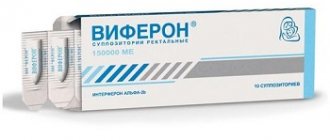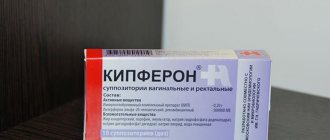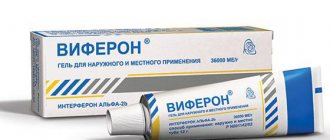A child’s body at a young age does not yet have a developed immune system, so it is susceptible to a large number of diseases. To prevent the child from contracting an infection, the young mother should have a remedy such as Viferon in her medicine cabinet. With its help, you can effectively eliminate the symptoms of viral diseases. The product fights well against ARVI, influenza, and also helps to cope with viral hepatitis, herpes and other diseases. This drug can also be used to prevent infectious diseases.
It is worth saying that this medicine is a drug that was developed by domestic pharmacological companies. In pharmacies it is offered in several forms: ointments, gels and rectal suppositories.
The drug is not sold in tablets , since the main active substance of this medicine, interferon, is quite fragile and bacteria located in the gastrointestinal tract easily decompose it.
When a newborn catches an infectious disease, the mother has great difficulty using this drug in gel form. It is not easy to apply it to the mucous membranes of the nose and mouth, which are dry due to the disease. In this case, the gel should be located precisely on the tonsils, so that it can then flow down the throat. And it is not possible to control this.
The drug in the form of an ointment cannot be used in all cases. It is usually used when lesions appear on the child’s body. For example, if your baby has herpes, then Viferon ointment will help cope with the rashes . However, it can only be used for young patients who are over one year old. Therefore, suppositories and suppositories are the most convenient form of medication, the intake of which can be easily controlled.
Composition and mechanism of action of Viferon
Due to the immaturity of the immune system, the body of newborn children is unable to fully respond to the effects of pathogenic agents. Infections can affect the baby even while passing through the mother’s birth canal or in the first days after birth.
Scientists have developed a drug that can be used for treatment at an early age and which causes almost no adverse reactions. Viferon is recognized as such a medicine.
It is produced:
- in the form of suppositories for rectal use,
- ointments,
- gel.
Often, infants are prescribed suppositories because they are quickly absorbed in the intestines, providing the necessary effect on the body, and are safe and convenient.
The basis of the antiviral agent is recombinant interferon alpha-2b. It is an artificially created analogue of the human protein produced by white blood cells in response to invading viruses. Once in the child’s body, synthetic interferon helps restore its own synthesis, prevents further reproduction of the pathogen and damage to healthy cells.
In addition to the artificially created protein, the drug contains additional components that reduce the likelihood of allergic reactions:
- tocopherol acetate (vitamin E),
- ascorbic acid (vitamin C),
- serum albumin (in the gel).
The presence of antioxidants increases the antiviral activity of the main substance and enhances immunomodulatory properties. Vitamins E and C have anti-inflammatory, membrane-stabilizing and regenerating effects. Due to the content of serum albumin in the gel, a thin film is formed on the mucous membrane and skin, protecting against the influence of pathogenic microorganisms.
Thus, the benefits of Viferon are as follows:
- Strengthening the immune response.
- Relieving inflammatory processes.
- Activation of tissue regeneration.
Interferon is characterized by high biological activity. One protein molecule significantly increases the resistance of one cell to infectious agents.
The use of Viferon makes it possible to reduce the dosage of antibacterial agents, which reduces the likelihood of side effects.
For what diseases can Viferon suppositories be used for newborns?
The list of diseases for which it is allowed to use this drug in the form of suppositories is quite wide. Not a single viral disease can be treated today without the use of Viferon. It is used to cope with colds, as well as to combat influenza in severe forms.
Below we provide a list of diseases for the treatment of which the use of Viferon in the form of suppositories is indicated:
- ARVI;
- flu;
- hepatitis of various types of viral nature that occurs in children. When treating them, Viferon is used in combination with other pharmacological agents;
- chlamydia, diseases of a bacterial nature, as well as herpes that occurs on the skin and mucous membranes of adult patients;
- influenza and ARVI in adult patients. In the treatment of these diseases, the drug is used in combination with other therapeutic drugs.
For women in an “interesting situation”, this drug can be used starting from the 14th week of pregnancy . There are no restrictions on the use of this medicine during lactation. The main side effect that may occur when using this drug for treatment is the appearance of itching and an allergic reaction on the skin.
After three days from the moment of administration of the suppository, these unpleasant symptoms disappear. Another contraindication to the use of this drug may be intolerance in the patient to individual components that are present in the composition of Viferon suppositories.
There is currently no information about the effects that occur during an overdose of the drug. In addition, Viferon suppositories combine well with other substances that are used to treat the diseases listed above. The shelf life of the drug is 2 years. However, correct storage conditions must be ensured. Viferon candles must be placed in a place protected from sunlight.
Dosage calculation
When determining the dosage of a medicine, the doctor proceeds mainly from the patient’s age. If the patient is a small child or infant, the specialist will adhere to the following recommendations:
- For newborns, the dosage should be one 150,000 IU suppository taken once every 12 hours. The course of therapy should last five days.
- For children who have a gestational age of at least 34 weeks, the dosage of a 150,000 IU suppository is given once every 8 hours. In this case, the duration of the course of therapy should not exceed 5 days.
Treatment can be carried out from one to three courses, each of which should last 5 days . This decision is made by the attending physician. The break between each course must be at least 5 days. It should be noted that during treatment, the dosage of more than 150,000 IU is not increased until the child reaches the age of 1 year.
Viferon 1 baby suppositories are prescribed for infants. For children whose age ranges from one to seven years, a specialist can prescribe Viferon 2. For young patients whose age ranges from 7 to 14 years, Viferon 3 is mainly prescribed. For older and adult patients, Viferon 4 is prescribed.
For treatment, it is necessary to purchase a drug that is prescribed for a specific age. In this case, harm to the child’s health will be excluded, and a situation where the treatment will not have any effect .
It should be said that Viferon is used not only as a medicine for an emerging disease. It is often prescribed as a preventative measure. A course of the drug can significantly increase the protective properties of the immune system, which is especially important on the eve of the cold period, which accounts for the increase in the incidence of colds.
Indications for use of Viferon
A drug with antiviral and immunomodulatory effects is used to treat various infectious and inflammatory diseases simultaneously with other medications.
Viferon for newborns is indicated when diagnosed:
- infections of the respiratory system, for example, rhinitis, laryngitis, pneumonia and bronchitis,
- hepatitis B, C and D,
- chickenpox, accompanied by damage to the mucous membranes,
- purulent-septic pathologies,
- herpes,
- herpes, chlamydia, mycoplasmosis, candidiasis acquired in the womb,
- infectious diseases of the central nervous system (CNS) such as polio, encephalitis, tetanus, meningitis.
Viferon helps reduce the frequency and severity of side effects that occur during treatment with antibacterial agents. Thanks to the use of a medicine containing interferon, it is possible to preserve the beneficial intestinal microflora.
The gel is used to prevent colds in infants. To create protection against infection, a small amount of the product is lubricated in the nasal passages.
The pediatrician should select the form of Viferon, as well as prescribe the dosage and duration of therapy. They depend on the diagnosis, the age of the child and his well-being.
Contraindications of the drug
Viferon is often well tolerated by the child’s body. Therefore, if a newborn needs help, doctors recommend the drug for a speedy recovery.
In rare cases, Viferon provokes the development of allergic reactions in the form of:
- itchy sensations,
- skin rashes.
Allergies can be caused by the cocoa butter contained in the drug. Accordingly, Viferon is not prescribed to infants with individual intolerance to the components of the drug.
If allergic manifestations are observed during the use of the drug, the doctor may discontinue the drug. After stopping Viferon therapy, undesirable symptoms disappear after 2-3 days.
Contraindications
These are determined only by sensitivity to one of the components of the drug. Its composition depends on the form of release. For example, suppositories (candles) contain vitamin C (ascorbic acid), vitamin E (tocopherol acetate), and cocoa butter. Almost each of them can act as an irritant and cause an allergic reaction. Since suppositories are the most suitable form of the drug for infants, this particular composition should be analyzed before using it in a baby prone to allergies.
There are no contraindications for the treatment of various diseases with medications of various types. Viferon is compatible and effective in combination with antiviral therapy, chemotherapy, etc.
Features of using Viferon candles
Viferon suppositories prescribed to infants differ from others in the amount of recombinant interferon contained in the suppositories.
Therefore, the specific type of suppositories is used depending on the patient’s age:
- Viferon 1 is recommended for children under one year of age. In these suppositories, the dosage of the main component is 150 thousand IU (international units).
- Patients who have reached the age of one year, but have not reached 8 years, must use Viferon 2. It contains 500 thousand IU of interferon.
- At the age of 12 you will need Viferon 3 with a million levels of interferon.
- Adolescents over 12 years of age and adults are prescribed drug No. 4. It contains 3 million IU of the main component.
It is important to use only the drug that is appropriate for the child’s age. If a baby is given suppositories with an inappropriate dosage, the treatment will result in a deterioration in well-being.
Viferon suppositories for infants are used for medicinal purposes 2-3 times a day, and for prevention they are placed twice a day. The duration of the therapeutic course is 5-10 days. When there is a need for re-treatment, a 5-day break should be taken. If the baby is premature, suppositories are placed 3 times a day every 8 hours.
Suppositories for rectal administration contain cocoa butter. Thanks to it, the drug dissolves faster in the rectum. On the other hand, if a candle is held in your hand for a long time, it quickly melts.
The advantage of using suppositories in infancy:
- easy administration and absence of significant discomfort,
- absence of negative effects of components on the gastric mucosa,
- rapid absorption into the blood, which speeds up the healing process.
To correctly place a candle on an infant, you must proceed as follows:
- Initially, hands are thoroughly washed with soap.
- The baby should be placed on his back or side in the fetal position (with knees bent).
- The suppository package is cut with sterile scissors or torn by hand.
- Having spread the baby's buttocks, you need to insert a candle into the anus to the length of the phalanx of the finger.
- After inserting the suppository, the buttocks contract and hold for several seconds.
- At the end of the procedure, you should wash your hands well.
To obtain a therapeutic effect, you should pay attention to useful recommendations regarding the use of suppositories in infancy:
- the suppository is placed after bowel movement (the medicine must remain in the rectum for at least 4 hours),
- before administering the drug, the anus can be treated with a small amount of oil to facilitate the administration of the suppository,
- the drug in the form of suppositories should be stored in the refrigerator and removed immediately before the procedure,
- It is important to distract the baby with something that might interest him, for example, a toy or a song.
If one of the family members has a cold or the flu, Viferon is given to the baby as a preventive measure. The medicine will strengthen resistance to infection and minimize the risk of infection.
How to place candles correctly
In order to administer the medicine correctly, the intestines must be emptied and the child must be washed.
It is also necessary to follow several important rules, namely:
- After bathing and washing, the baby's body should be wiped dry. In this case, you should not use special products - this should only be done if the skin is very dirty.
- Before using the suppository, it must be carefully removed from the package, but since the suppository melts quickly, it should be immediately inserted into the child’s anus.
- Place the baby on its side and gently spread the buttocks with two fingers to administer the product rectally.
- After this, carefully insert the candle with its sharp tip forward so that it is immersed to the length of one phalanx of the finger - this way the medicine will better enter the rectum and will not fall out. It is important to note that suppositories melt too quickly, so if the person administering the medicine gets a little oily on their fingers, it will be difficult to quickly insert the suppository into the rectum.
- After this, the child needs to be turned over on his stomach and allowed to lie down for 10-15 minutes, during which the medicinal product will completely dissolve and its active components will be absorbed into the walls of the rectum. If the candle spills out in the next half hour, then you won’t have to expect a quick therapeutic effect. Therefore, you need to try to persuade the child to lie down for 15 minutes so that the drug has time to have an effect on the body.
Why is it recommended to insert suppositories into the anus? Rectal use of suppositories allows the active components of the drug to quickly penetrate the patient’s bloodstream, resulting in a complex effect on the body. As a result, the patient’s resistance to pathogens increases several times due to the active production of interferons. This allows you to quickly destroy viruses that cause the development of many diseases, as well as increase the protective capabilities of the immune system.
In order for Viferon to be completely absorbed into the walls of the rectum, doctors advise administering the medicine before bedtime, when the baby no longer wants to get out of bed, as he will be sleepy. This is especially true for infants and children under 3 years of age, who are quite active. After all, it is known that even newborns and premature babies can use suppositories as a treatment, since the medicine does not contain any hazardous components that could harm a newly born baby.
You should not prescribe the drug to your child on your own, since this requires taking into account its dosage. It is known that Viferon is available in several doses, the purpose of which directly depends on the patient’s health condition and his age.
Before using suppositories, you need to visit a doctor and get advice on how to insert suppositories correctly, and what rules need to be followed so that the medicine has the maximum therapeutic effect.
Using ointment and gel
Viferon ointment for infants, like the gel, effectively fights infections.
A yellow ointment with the smell of lanolin is applied to the affected areas of the skin 3-4 times a day:
- for herpetic rashes,
- if there are papillomas on the body,
- with chicken pox,
- for shingles,
- if external otitis is diagnosed, affecting the skin of the auricle.
Viferon-gel for infants is a white, opaque substance. Typically, the product is used to lubricate the tonsil mucosa for viral tonsillitis. However, it is difficult for an infant to carry out such a procedure.
With the help of Viferon in the form of a gel, children under one year of age are treated with the nasal mucosa instead of Oxolinic ointment. Such preventive actions are appropriate during the season when the number of colds increases. To protect the child, before leaving the house, his nasal passages should be lubricated with a small amount of the drug. The gel can be used twice a day.
There are some differences between ointment and gel. The ointment can moisturize the treated mucosa, and the gel, on the contrary, dries it out.
When is VIFERON Suppositories prescribed for infants?
For the treatment of ARVI, including influenza, including those complicated by bacterial infection, pneumonia, the drug VIFERON is used. Suppositories (suppositories) can be used to treat babies from the first days of life. The dosage of the drug for infants is as follows. Premature newborns with a gestational age of less than 34 weeks are prescribed the drug 150,000 IU, 1 suppository 3 times a day after 8 hours every day for 5 days. According to clinical indications, therapy can be continued. The break between courses is 5 days.
Children under 7 years old, incl. newborns and premature infants with a gestational age of more than 34 weeks are prescribed VIFERON Suppositories (suppositories) 150,000 IU, 1 suppository 2 times a day after 12 hours every day for 5 days. According to clinical indications, therapy can be continued. The break between courses is 5 days. This dosage, according to the instructions, is used from 0 to 7 years.
Reviews from parents about the use of Viferon for infants
The popularity of the antiviral drug among parents with small children is explained by the positive effect of Viferon on the child’s body. The smaller the child, the more difficult it is for him to fight viruses and bacteria.
Many medications for infants are prohibited because they can cause serious deterioration in well-being.
Viferon quickly gained trust because:
- It has a convenient dosage form (suppositories).
- Its use does not harm the child's body.
- If the dosages are observed, there are no side effects.
- The child recovers faster.
Parents note that Viferon helps reduce harm from the simultaneous use of antibiotics. Moreover, Viferon gel, suppositories and ointment are excellent means for preventing ARVI (acute respiratory viral infections) and influenza.
Negative reviews about Viferon are associated purely with allergic reactions. If they are present, doctors replace the drug with Grippferon. It does not contain cocoa butter.
Recommendations for parents on purchasing and storing medications for children
In order for the treatment of both infants and older children to be effective and lead to the desired results, it is necessary to adhere to several rules:
- When purchasing medications for children, carefully study the packaging, monitor the date of manufacture, shelf life and storage conditions of the medications;
- be sure to check the presence of a description leaflet on the use of the selected medication, make sure that it can be used to treat a child;
- strictly follow the dosage and duration of treatment;
- do not buy medications for your child in advance and without a doctor’s prescription, except those in which you are completely sure;
- do not leave medicine packages open or in the wrong place;
- Get into the habit of regularly checking your home first aid kit every 3-4 months, and get rid of expired medications on time.
Reference and information material
Author of the article
General doctor
- Nesterova I.V. “Interferon drugs in clinical practice: when and how,” “Attending Physician,” September 2021.
Source











